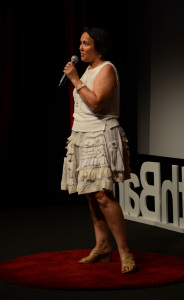 Brisbane-based upcycler Jane Milburn spent every day of 2014 restyling cast-off clothing and engaging others in the process of refashioning old into ‘new’ as part of the eco-social change project Sew it Again.
Brisbane-based upcycler Jane Milburn spent every day of 2014 restyling cast-off clothing and engaging others in the process of refashioning old into ‘new’ as part of the eco-social change project Sew it Again.
Using simple home-sewing skills to snip-and-tuck unworn textiles (mainly linen, cotton, wool and silk from op shops and friends) Jane then posted the upcycles at sewitagain.com to demonstrate ways to re-new rather than buy-new.
“Every day, we eat and we dress. We are now more conscious of our food and it is time to become conscious of our clothing and its footprint on the world. A global rethink about the way we dress is beginning, as people question where clothing is made and what from, is it ethical and sustainable, and does it exploit people or planet?” Jane said.
As an agricultural scientist turned creative, Jane is raising awareness about the ecological impacts of our cheap/disposable fashion culture that consumes finite resources and generates textile waste at an alarming rate.
Figures from various sources indicate Americans throw away 30kg of textiles/person/year, the United Kingdom and Hong Kong about 13kg/person/year, and Australians donate about 5kg each/year. Other clothing insights are:
- 2/3 of new clothing is now made from synthetic fibres, derived from petroleum, coal or gas – and each time synthetic clothing is washed, microplastic particles shed into wastewater to pollute our shores
- Australia ships 70 million kgs of cast-off clothes to developing nations every year – where it ultimately ends up being burned or buried
- About 1/3 of clothing goes prematurely to landfill in the United Kingdom, and likely in Australia too
“The greenest clothing of all is that which already exists. The slow fashion movement is opening our eyes about clothing in the same way the food movement raised awareness about food miles, waste and production ethics, as well as the negative impact of processed food,” Jane said.
“Refashioning existing clothing – as previous generations have done – appeals to those concerned about textile waste and prepared to be creatively resourceful in how they dress instead of following the crowd.
“Clothes have stories: Reusing garments that would otherwise languish in cupboards or be dumped is an exciting way to create something unique and wearable that can be endlessly patched, mended or adapted further, adding even more character to the story of how it came to be. “
If upcycling is not your thing, you can dress with conscience in other ways: choose timeless styles; support local designers; buy ethical brands; prefer natural fibres; wear vintage; care for clothes and buy less of better quality.
“Processed food and cheap fashion are convenient – but not necessarily sustainable or good for us and our planet. When we are individually more careful in our clothing choices, we can collectively reduce waste and excess which is wearing out the world.”